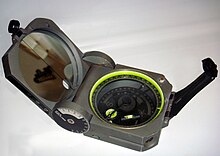Thành viên:Tranletuhan/Thử 1
Tranletuhan/Thử 1
Đường phương và góc dốc[sửa | sửa mã nguồn]


Đường phương và hướng dốc là các yếu tố thế nằm của các lớp đá, khe nứt hay đứt gãy. Đường phương của lớp đá, đứt gãy là một đường giao tuyến của đối mặt lớp hay mặt đứt gãy với mặt phẳng nằm ngang. Trên bản đồ địa chất, đường phương được thể hiện bằngn một nét ngắn có hướng song song với đường phương đo đạc ngoài thực địa. Giá trị đo của đường phương thường được biểu diễn theo độ nằm trong khoảng 0-180 độ, nếu giá trị đo bằng la bàn lớn hơn 180 độ thì có thể quy về khoảng 0-180 bằng cách trừ đi 180 độ, hoặc có thể biểu diễn theo phương Bắc-Nam, Đông-Tây.
Đường dốc là đường thẳng nằm trên mặt lớp đá, đứt gãy và vuông góc với đường phương, chứa đường hướng dốc. Đường hướng dốc là đường nằm trên đường dốc và có hướng chỉ về phía lớp đất đá, đứt gãy đó cắm xuống. Hướng dốc là hình chiếu của đường dốc trên mặt phẳng nằm ngang.



Another way of representing strike and dip is by dip and dip direction. The dip direction is the azimuth of the direction the dip as projected to the horizontal (like the trend of a linear feature in trend and plunge measurements), which is 90° off the strike angle. For example, a bed dipping 30° to the South, would have an East-West strike (and would be written 90°/30° S using strike and dip), but would be written as 30/180 using the dip and dip direction method.
Strike and dip are determined in the field with a compass and clinometer or a combination of the two, such as a Brunton compass named after D.W. Brunton a Colorado miner. Compass-clinometers which measure dip and dip direction in a single operation (as pictured) are often called "stratum" or "Klar" compasses after a German professor.
Any planar feature can be described by strike and dip. This includes sedimentary bedding, faults and fractures, cuestas, igneous dikes and sills, metamorphic foliation and any other planar feature in the Earth. Linear features are measured with very similar methods, where "plunge" is the dip angle and "trend" is analogous to the dip direction value.
Apparent dip is the name of any dip measured in a plane that is not perpendicular to the strike line. True dip can be calculated from apparent dip using trigonometry if you know the strike. Geologic cross sections use apparent dip when they are drawn at some angle not perpendicular to strike.
References[sửa | sửa mã nguồn]
- Compton, Robert R. (1985). Geology in the Field. New York: J. Wiley and Sons. ISBN 978-0471829027. OCLC 301031779.
- Lahee, Frederic Henry (1961) [1916]. Field Geology (ấn bản 6). New York: McGraw-Hill. OCLC 500832981.
- Tarbuck, Edward J. (2008). Earth: An Introduction to Physical Geology (ấn bản 9). Upper Saddle River, N.J.: Pearson Prentice Hall. ISBN 0131566849. OCLC 70408067. Đã bỏ qua tham số không rõ
|coauthors=(gợi ý|author=) (trợ giúp) - “Digital Cartographic Standard for Geologic Map Symbolization”. FGDC Geological Data Subcommittee. USGS. tháng 8 năm 2006. Truy cập ngày 20 tháng 3 năm 2010.
